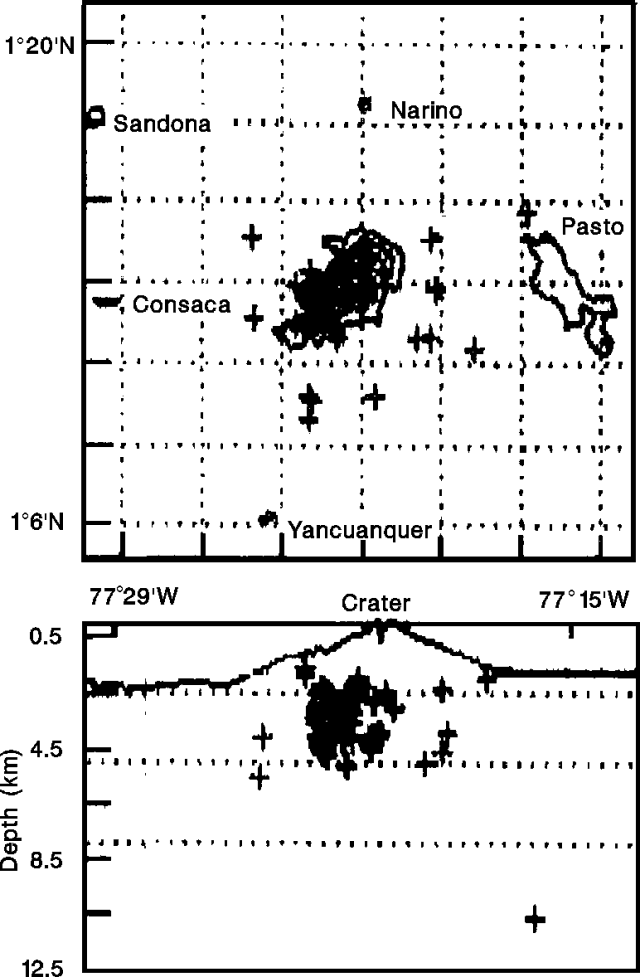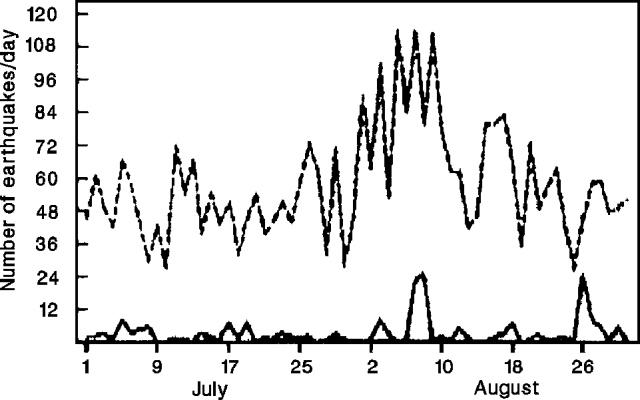Report on Galeras (Colombia) — August 1990
Bulletin of the Global Volcanism Network, vol. 15, no. 8 (August 1990)
Managing Editor: Lindsay McClelland.
Galeras (Colombia) Small tephra emissions, perhaps with minor magmatic component; strong seismicity and fumaroles
Please cite this report as:
Global Volcanism Program, 1990. Report on Galeras (Colombia) (McClelland, L., ed.). Bulletin of the Global Volcanism Network, 15:8. Smithsonian Institution. https://doi.org/10.5479/si.GVP.BGVN199008-351080
Galeras
Colombia
1.22°N, 77.37°W; summit elev. 4276 m
All times are local (unless otherwise noted)
Ash emissions and geology. Small ash emissions occurred 2 and 15 August. The activity on 2 August was preceded by an increase in the number of long-period earthquakes (figure 25) and accompanied by low-frequency tremor. Explosions ejected blocks as large as 15 cm in diameter up to the S-SW rim of the inner crater, and deposited a 3-4-cm layer of fine gray ash over a tight sector N and W of the crater. Seismic signals and the dispersion of deposits suggested that there could have been as many as three explosive events. S. Williams reported that "close examination of the 2 August ash under the petrographic microscope revealed a small (<1%) component of shiny fresh glass shards and enclosed crystals. The remainder of the deposit was entirely composed of lithic material, crystal fragments, and accessory material. Within the glassy specimens, there appeared to be two different types – one brown and the other (less common) clear. The petrographic characteristics of these shards was consistent with their having been erupted as fresh magmatic material."
The 2 August explosions took place at the "Las Portillas" fumarolic area at the W wall within the inner crater. An increase in size of the fumaroles was noted.
Seismic activity. Long-period earthquakes increased in number during August, to the highest level since the initiation of monitoring at the volcano. Frequencies of the long-period events ranged from 1.25 to 1.67 Hz. Some were monochromatic and others alternated with high frequencies. Occasionally, they were linked to low-frequency tremor signals. The majority of the tremor episodes were of low frequency, with less frequent spasmodic tremor; signals often had poorly defined forms. Tremor episodes were associated with ash emissions on 2 and 15 August, and had up to 16 cm2 of reduced displacement (2 August).
High-frequency earthquakes were concentrated W of the crater at 2-5 km depth; others were located to the SE at similar depths (figure 26). A M 3.6 earthquake (the largest yet recorded at Galeras) occurred on 30 August, 4 km SE of the crater and at close to 4 km depth. A number of dynamic parameters of the high-frequency sources were determined: seismic momentum ranged from 1018-1021 dyne-cm with an average of 1020 dyne-cm, fault longitudes ranged from 125 to 325 m with an average of 200 m, fault dislocations and stress drop ranged from 0.1 cm and 1.5 bars (respectively) for an M 1.2 earthquake to 58.3 cm and 796 bars for an M 2.2 earthquake.
 |
Figure 26. Epicenter map (top) and E-W cross-section showing focal depths (bottom) of 76 high-frequency earthquakes recorded at Galeras, August 1990. Courtesy of INGEOMINAS. |
Deformation. There were no significant changes in deformation, with the exception of peaks noted 2 km E of the crater (Peladitos EDM station) on 17 and 19 August. No clear relationship with seismicity was evident.
Gas geochemistry. The SO2 flux, as measured by COSPEC, fluctuated between 1,343 and 3,023 t/d during 10 measurements in August. The following is a report by S. Williams.
"The Las Deformes fumarole, ~10 m outside of the S lip of the inner crater, appeared to be roughly 25% larger than it was when visited in December 1989. Temperatures as high as 243°C were measured, where the maximum in December was 225°C. The fumarole had a very high-pressure noisy output of gas, with a very high SO2 content. Sublimate minerals within the highest temperature zones of the fumarole were black shiny crystals. Unfortunately, none were successfully collected. The Calvache fumaroles, NE of the crater, had maximum temperatures of 88°C, unchanged from December 1989. Increased activity was noted around the Calvache fumaroles. Giggenbach-type samples were collected from both fumaroles and condensate was collected at Las Deformes. The inner crater fumaroles could not be approached closely, due to the large volumes of gas and poor visibility. Their overall appearance was consistent with significantly higher temperatures (>500°C?) than encountered outside of the crater. At Pandiaco hot spring at the E foot of the volcano (in Pasto) the pH was 6.1 and temperature was 30°C, unchanged from December 1989 and April 1988 (when the site was first visited).
"A mudflow occurred on 28 April, apparently triggered by a heavy rain with no relation to eruptive activity. The flow swept down the river draining Galeras on its breached W side and went past Consacá (10 km W of the crater), to the Río Guitara. At the bridge just above Consacá, the mudflow scoured up to 5 m above the normal banks.
"Galeras is still in a very (and perhaps increasingly) active state, dominated by magmatic processes."
Geological Summary. Galeras, a stratovolcano with a large breached caldera located immediately west of the city of Pasto, is one of Colombia's most frequently active volcanoes. The dominantly andesitic complex has been active for more than 1 million years, and two major caldera collapse eruptions took place during the late Pleistocene. Long-term extensive hydrothermal alteration has contributed to large-scale edifice collapse on at least three occasions, producing debris avalanches that swept to the west and left a large open caldera inside which the modern cone has been constructed. Major explosive eruptions since the mid-Holocene have produced widespread tephra deposits and pyroclastic flows that swept all but the southern flanks. A central cone slightly lower than the caldera rim has been the site of numerous small-to-moderate eruptions since the time of the Spanish conquistadors.
Information Contacts: INGEOMINAS-OVP; S. Williams, Louisiana State Univ.


